Google “Mexican Orange Plant” and you will get results for the Four most common Choisya bushes, and significantly none of them grows oranges! So what exactly is The Mexican Orange, and if I want one which of the four plants should I buy and why? Funny enough I have all four in my garden, therefore I can show you.
Choisya Mexican Orange Plants – Which One is The Best? I will show you the four most popular Choisya bushes and go through with you the differences by comparison. We will look at the sizes, the cost, the flowering period and most important the fragrance that you would expect these shrubs to give. I will also take you through where these shrubs can be planted, the general aftercare they need and problems that could occur.
This item contains affiliate links. We may earn a small commission off these links at no additional cost to you. To learn more please visit our “About Us” page.
What is a Mexican Orange Plant?
Mexican Orange Plants are aromatic ornamental evergreen shrubs native to Mexico and the Southern United States, generally known as Choisyas. Markedly named after Swiss botanist Jacques Denys Choisy (1799 – 1859).
They don’t grow oranges, but their flowers and scent are similar to orange blossoms.
The most common Mexican Orange Plants are:
- Choisya ternata.
- Choisya ternata ‘Sundance’.
- Choisia dewitteana ‘Aztec Perl’.
- Choisia dewitteana ‘White Dazzler’.
Choisya ternata Mexican Orange.
Without a doubt the most common Mexican Orange is Choisya ternata.

- Height: 8ft (2.5 metres) Spread 8ft (2.5 metres).
- Growth Rate: 1 – 2ft (30 – 60cm) per year.
- Leaves: Dark Green 4in (10cm) x 1.25in (3cm).
- Flowers: 1.25 in (3cm) six white petals yellow stamens.
- Flowering period: May and September.
- Cost: £22 ($26).

You can purchase Choisya ternata plug plants from Amazon by using the clickable image below:

Choisya ternata ‘Sundance’.
The most decorative Choisya, when not in flower is the Choisya Sundance.
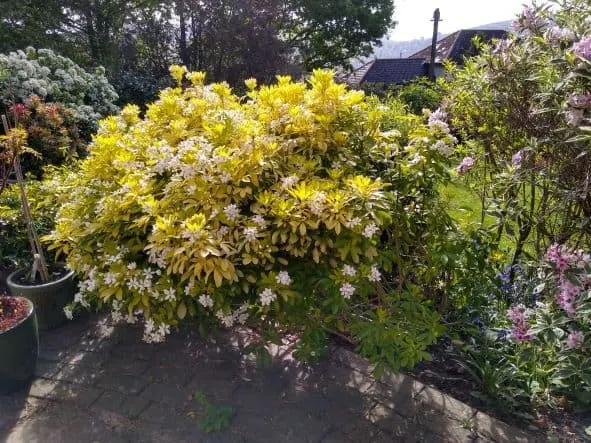
- Height: 8ft (2.5 metres) Spread 8ft (2.5).
- Growth Rate: 10 – 16 Inches (25 – 40cm) per year.
- Leaves: Light Green/Yellow 3in (8cm) x 1.25in (3cm).
- Flowers: 1.75 in (4.5cm) six white petals yellow stamens.
- Flowering period: April to May and August to September
- Cost: £23 ($27).
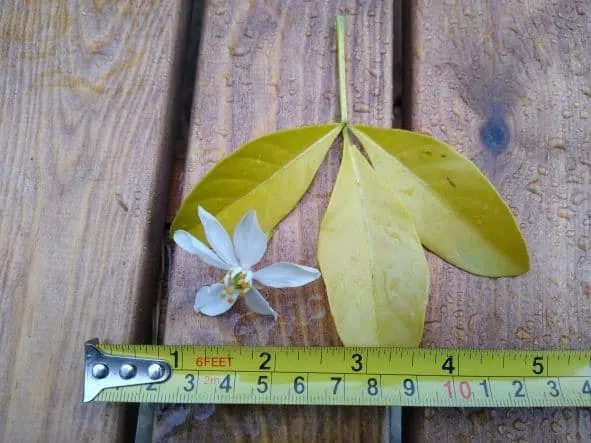
You can purchase a Choisya ternata ‘Sundance‘ from Amazon by using the clickable image below:

Choisya dewitteana ‘Aztec Perl’.
Good for hedging is the Aztec Perl, owing to its smaller leaves that can be pruned with an electric cutter.
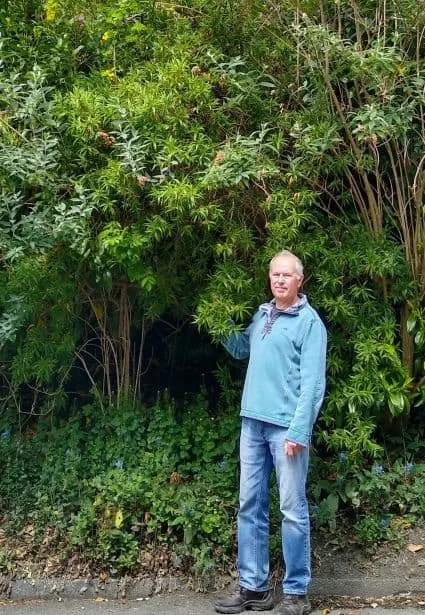
- Height: 8ft (2.5 metres) Spread 8ft (2.5).
- Growth Rate: 10 – 16 Inches (25 – 40cm) per year.
- Leaves: Dark Green 3in (8cm) x 0.4in (1cm)
- Flowers: 1.25 in (3cm) five white petals yellow stamens.
- Flowering period: May and September.
- Cost: £23 ($27).
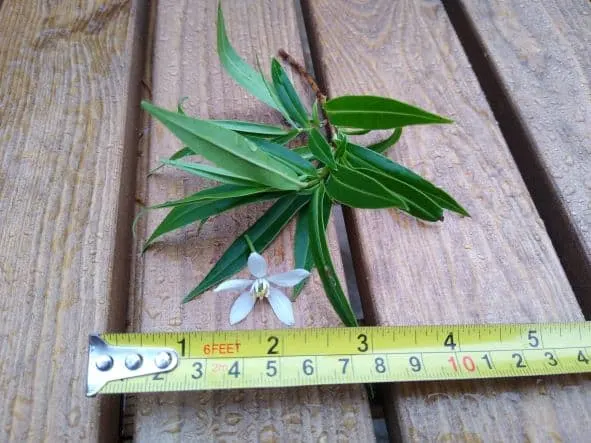
Choisya dewitteana ‘White Dazzler’.
The best small Choisya without doubt is the White Dazzler. It is a relatively new plant that was bred by Peter Moore in the UK, you can read about him on his website “bredbypetermoore.co.uk“.
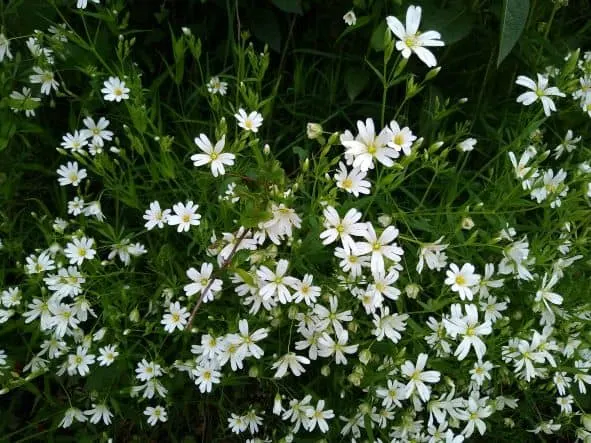
- Height: 5ft (1.5 metres) Spread 5ft (1.5).
- Growth Rate: 8 -12 Inches (20-30cm) per year.
- Leaves: Lime Green 1.5in (4cm) x 0.25in (0.5cm)
- Flowers: 1 in (2.5cm) five white petals yellow stamens.
- Flowering period: April to May and August to September
- Cost: £15 ($17).
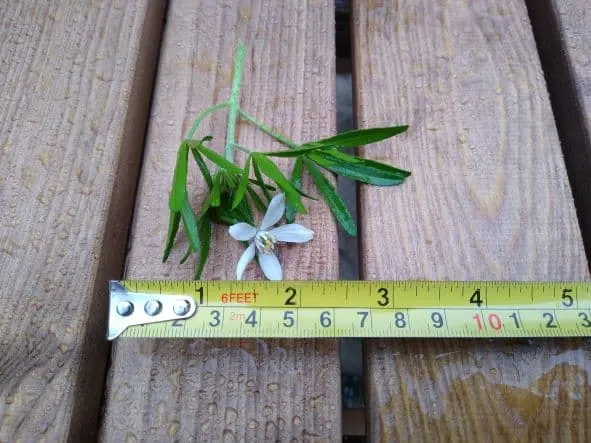
You can purchase a Choisya dewitteana ‘White Dazzler’ from Amazon by using the clickable image below:

Which Mexican Orange Is Most Fragrant?
Sheila and I both agree on this answer (which is unusual to be sure).
4th place goes to: White Dazzler. You can smell orange blossom but only just.
3rd place goes to: Aztec Perl is comparatively a little bit better.
On individual flowers only:
In 2nd place: Choisya ternata. The fragrance is by and large about twice as strong as the other two.
Winner: The most fragrant FLOWER is Choisya ternata ‘Sundance’. The shrub has Larger flowers with a very strong fragrance.
On the shrub:
Winner: The most fragrant BUSH is Choisya ternata. The shrub has about 2 – 3 times as many flowers as the Sundance, therefore the scent is increased. When we sit outside on a summer evening, the Choisya ternata is very fragrant indeed.
Which Mexican Orange Plant Is The Best?
If space in your garden is an issue, or you want to grow in a container, perhaps on a balcony then the “White Dazzler” is ideal buy for you. Of the four it takes up the least amount of space, it is very decorative, will take a light pruning, and as a bonus, it cost a little less than the other 3.
If it’s the fragrance that is your objective, then the common “Choisya ternata” is the ideal buy. I just went outside (16th May UK) and straightaway I could smell the Mexican Orange Plant. The shrub is also good to plant alongside a fence or to make a hedge boundary.
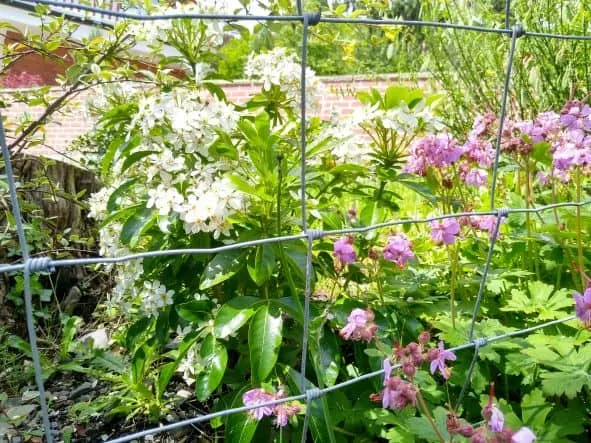
As Choisyas are NOT in flower for 80% of the time, the most decorative in truth is the “Sundance“. The light green almost yellow colour of this evergreen will unquestionably brighten any garden in winter. As I have said the fragrance of this plant is also very high indeed.

If a hedge is what you are after then the “Aztec Perl” is the best, as it grows high, the foliage is dense, and it is quite happy to be cut harshly with shears or an electric hedge trimmer (after flowering). An added bonus is that trimming it will encourage it to flower again later in the year. However if you are impatient to grow a hedge then “Choisya ternata” is the fastest growing Choisya.
How to Make a Mexican Orange Plant Flower Twice a Year.
Immediately after flowering prune your Choisya and it will produce flowers again later in the year.
A mature shrub can be pruned hard, 10 – 12 inches (15 – 30cm) especially the “Choisya ternata“.
Go a little easier on the “Sundance and the “Aztec Perl“, prune 6 – 8 inches (15 – 20cm), finally in the case of the “White Dazzler” go very easy, prune 3 – 4 inches (7 – 10cm).
Be careful pruning an immature shrub, and in all cases NEVER prune more than one-third.
After pruning give the Mexican Orange a feed with “All-Purpose Fertilizer” such as miracle-gro, or even better make your organic feed using nettles or comfrey. See the section “Homemade Plant Food” in our posting “23 Budget Small Garden Ideas by Mr Cheap” for more details.
Where to Site Your Mexican Orange Plant.
Your Mexican Orange shrub will grow in any soil type as long as it is well draining. For clay soil dig in some homemade compost, sharp sand and horticultural grit to avoid immature roots from rotting. See the section “Clay Soil” in our post “How to Start a Garden Bed, and Pick Suitable Plants” for more details.
Position your Mexican Orange in full sun if you can, especially the Choisya ternata, the Choisya ternata ‘Sundance’ and the Choisya dewitteana ‘Aztec Perl’. The Choisya dewitteana ‘White Dazzler’ will tolerate part shade better than the other three.
When planting DO NOT plant deeper than the pot that it came in, to avoid fungal infection.
Mexican Orange Plant Issues.
Choisyas are very hardy plants and rarely have issues, however should you see these signs:
- Drooping leaves: in drought conditions. If this occurs get the hosepipe out and give the shrub a good watering. Young plants need to be watered frequently in their first season until their roots have established.
- Yellowing leaves: This is normal for the “Sundance”, but the others may have an issue. Waterlogging is often the cause in a rainy summer. Spike the ground around the shrub with a fork to aid drainage and get air to the roots.
- Phytophthora root rot: Extremely wet conditions will cause Phytophthora Root Rot. There are no chemical treatments, unfortunately. Spike the ground, but most likely the plant will die.
- Split Branches: Often caused by heavy snow on the bush in the winter. Get a broom and knock the layers of snow off the shrub before this happens.
- Slug Damage: Slugs are attracted to Choisyas. Not that often but they will cause damage. To dissuade slugs read “Stopping Holes Caused by Slugs” section in our post “How to Stop Holes in Homegrown Potatoes“.
- Spindly growth: Insufficient nutrients, especially calcium, boron, manganese, zinc, molybdenum, or copper. Fertilize the shrub using “All-Purpose Fertilizer”. Bad positioning in extremely poor and dry soil, or an exposed windy position will cause spindly growth. If the Choisya shrub is small enough move it to a more sheltered spot if you have one.
Looking After a Choisya.
Compared to other shrubs, Choisya need very little care, but never the less:
- Keep it watered, especially in very dry spells in the summer months.
- Deadhead spent flowers using shears, to make it flower again in late summer.
- Feed in late spring after pruning, as detailed earlier.
- Give it a mulch of compost in early spring. Spread the mulch thinly around the shrub DO NOT put mulch up to the trunk as this will cause fungal problems. See our post “How to Make Soil Acidic Naturally, Easy Composting” to learn how to make mulch.
How to Propagate a Choisya.
There are “Plant Breeders Rights”, associated with propagating Choisyas so be aware the “Green Police” will come knocking if you:
- Use clean pruners to take a semi-ripe cutting selected from this season’s growth. take in late summer. The tip must be soft and the base hard.
- Trim the cutting between 4 – 6 inches (10-15cm), cut just below a leaf node.
- Remove the lower leaves, leave 3 or four at the top.
- Dip the cutting in “hormone rooting powder”.
- Plant cutting in a pot of 1 part compost 1 part perlite. If you don’t have perlite use horticultural grit or sharp sand.
- Water the cutting and let it drain.
- Cover with a clear polythene bag and rubber band.
- Put three holes in the bag to allow ventilation.
- Put in warm light area indoors, or in a greenhouse.
- Check periodically that the soil is moist.
- The cutting will start to root in 6 to 8 weeks.
- Put a tear in your T-shirt, repair it with safety pins, and play “Anarchy in the UK”, at full volume on your gramophone.
Have a great gardening experience.
